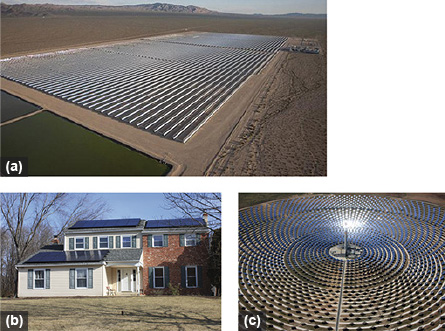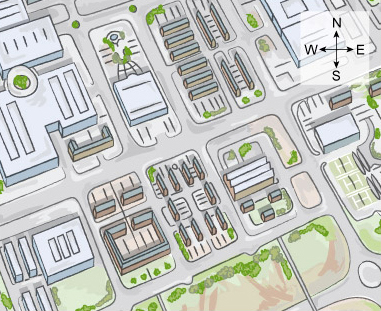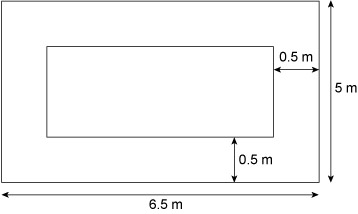5 The solar century
In the present-day UK more and more homes are making use of solar panels to convert the Sun’s energy into electricity or hot water. This can mean cheaper bills at a time when energy is becoming an increasingly scarce resource and thus more expensive. Figure 10 shows some images of energy generation from the Sun. The size and arrangement of some of the solar arrays in the desert can be truly astounding.

Many new houses have solar panels built into the fabric of the building (for example those in Figure 10b, above) and it is an area that will become increasingly important in our future energy generation. The solar panel technology has been developing since the invention of photovoltaic technology (which is the technology used in solar panels that convert solar energy to electricity) in the mid 1950s and, although still expensive, is now becoming increasingly viable for meeting a home’s energy requirements. To function effectively, however, solar panels need as much direct sunlight as possible and this means that orientation is key.
Activity 9 Which roof is better for solar panels?
The figure below shows one of the terraced streets you saw when you did Activity 6. Some of the buildings in the drawing have ‘pitched’ roofs – ones where the two sides of the roof are sloping and meet along a ridge – these are ideal for mounting solar panels. As before, north is towards the top of the figure. Look at the figure and, for two or three different houses or buildings, work out which bit of roof would generate the most electricity from solar panels. What implications does the constantly moving Sun have for solar panels?
Discussion
You would put your panels on the part of the roof that was most south-facing. In the figure, there are no roofs that face directly south (towards the bottom of the photo) but there are plenty of roofs which face south-east or south-west. The big building at the bottom of the photo, for example, has a large expanse of roof facing south-east that would be ideal to mount some solar panels.
Although solar technology has developed so that the angle of the sunlight is less important, the more direct the sunlight – the more it falls at a 90° angle (a right-angle) onto the solar panel – the better. This means that solar panels that ‘track’ the Sun as it moves through the sky could potentially generate more energy. Imagine, for example, a field of sunflowers, and how the head of each sunflower moves to face the Sun right through the day to capture as much Sun as possible.
A drawback might be that the energy used by the tracking system would detract from the energy generated as well as needing more maintenance, so in practice what’s called a ‘static array’, provided it is south-facing, is the cheapest and most efficient.
Activity 10 Katie’s house
Question 1
- a.What is the area of the south-facing roof panel?
- b.Katie has been advised to leave a 0.5 m border around the edge of her roof as shown in above. What area is available for solar panel use?
Discussion
- a.The area of the south-facing roof is 6.5 m × 5 m = 32.5 m2.
- b.5 m – (2 × 0.5 m) = 4m.
The length of the rectangle in which solar panels can be fitted is 4 m.
Similarly the width of the rectangle is 5.5 m.
This gives an area of 4 m × 5.5 m = 22 m2.
Question 2
The roof panels Katie is looking at measure 1.6 m (length) by 0.9 m (width). The panels fit exactly next to each other with no overlap or gap. The panels have to be fixed so their length is along the length of the roof.
- c.How many panels can Katie fit in the available space on her roof?
- d.Find the area of a roof panel. Explain why your answer to part (c) is not the same as the calculating the area of the roof space available divided by the area of a roof panel.
e.Each panel gives 200 watts (W) of power. Using your answer to part (c), find out how much power Katie will get from her solar panels. Give your answer in kilowatts (kW) to 1 d.p. The watt is the SI unit for power, and a kilowatt is 1000 watts. Hence to convert from W to kW, divide by 1000.
Discussion
- c.The panels stay in the same orientation.
5.5 m ÷ 0.9 m = 6.111.
Across the width we can fit 6 panels.
4 m ÷ 1.6 m = 2.5
In the length we can fit 2 panels. This means there is room for 12 panels on the roof altogether.
- d.Find the area of a roof panel. 1.6 × 0.9 = 1.44 m2. Divide the available roof area by the panel area. 22 ÷ 1.44 = 15.3 (1 d.p.).
The difference arises because we round the values for the length and width before multiplying in the first case. We can’t use bits and pieces of panels to cover the area but can only work in whole panels.
- e.There are 12 panels each giving 200 W of power. 200 W × 12 = 2400 W.
So we get 2400 W of power in total. To convert to kilowatts (kW), divide by 1000.
2400 W ÷ 1000 = 2.4 kW.
So, the system will give 2.4 kW of power.


